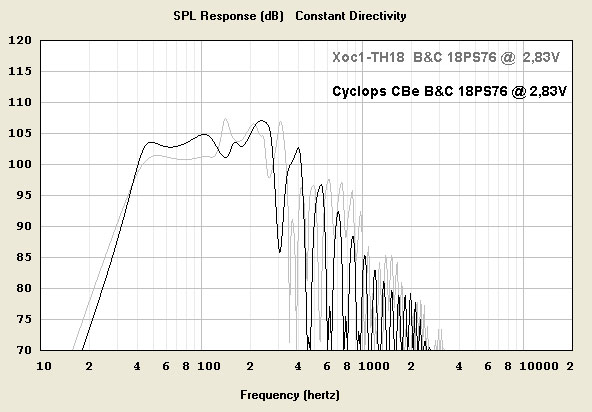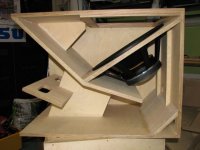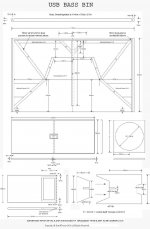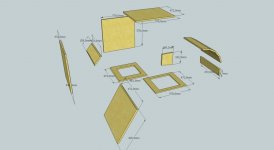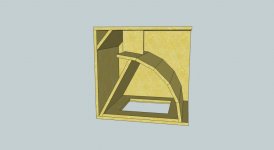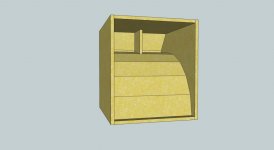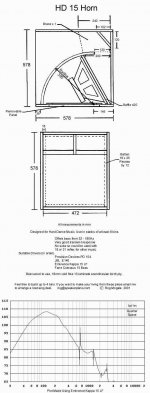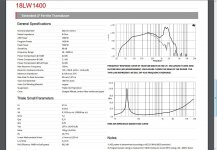JAG,
1) Presumably those interested in XOC1 TH18 design are considering it because of it's relatively small size of around 15 cubic feet (416 liter) exterior volume, high output, and low frequency response. What "case" of a front loaded horn of 416 L exterior volume would compete favorably in terms of SPL and low corner?
I could sim something up if you really want.
3) Having began my career using drivers with 100 to 400 watt potential (the 400 watt drivers being less sensitive, having only a few dB at best more output potential), I did not find them to be "boring", other than the requirement of lugging around a lot more plywood and fiberglass to achieve what modern drivers are capable of.
The difference is a lot less than you make it out to be, as the heavier, higher power drivers are inevitably less sensitive than their lighter counterparts, resulting in some of the additional power required to move the additional moving weight not being used as effectively, causing more relative Re increase.
Although I won't go back to using drivers with less Xmax due to my professional self-imposed size and weight use restrictions, if size and weight are not a primary issue, lower Xmax drivers that are in abundance both new and used can be a more cost-effective solution to providing a given SPL than modern heavy MMS high excursion drivers for those willing to lug and store more cabinets.
For some markets, the size of the stack is more important than the output, so the cheaper drivers can be doubly cost effective, and doubling frontal area and cone area can result in a 6 dB increase in level, so will actually achieve far more "breathtaking" results than the same power used with high Xmax/Mms drivers.
Art
All true, but you have to consider the cost/performance ratio too. When you consider the cost of wood and a quality finish for the cab, and especially if you have to pay someone to build it, a couple of db extra from a more expensive driver can be well worth the extra cost.
OP has made it quite clear on several occasions that he wants a small and lightweight cab. In that case power density can be a great benefit. But not if he only plans to use 600 watts, in that case it doesn't matter that much.
From my own personal experience though, I know that every time I add more to my system all it does is make me want more. I don't think that's a particularly uncommon experience, there are dozens (maybe thousands) of threads devoted to this "disease". So sometimes it makes sense to plan for the inevitable before it's a reality that is more costly to upgrade than it would have been to do it right in the first place.
And I guarantee that 600 watts will becoming boring very quickly. You will find that you want more. A lot more.
I went digging through articles on horns, one touching on the sound system used at woodstock.
One individual suggested the entire system ran on about 1200 watts. (rms)
I went digging through articles on horns, one touching on the sound system used at woodstock.
One individual suggested the entire system ran on about 1200 watts. (rms)
Whether or not that's true, Woodstock used an incredible amount of high efficiency drivers so it wouldn't take much to make them loud. It also wouldn't take much to reach their excursion limits either, as drivers of that time period didn't have a whole lot of excursion potential.
So take all those high efficiency drivers, stick them in enclosures with a very high tuning and you can make a LOT of noise with very little power.
Trying to get the most power density out of the smallest cab possible with a low(ish) tuning is exactly the opposite of the sound system you are talking about. Ask LORDSANSUI if he's willing to build and transport a system that size that can't hit his desired low frequency tuning and see what he says.
JAG,From my own personal experience though, I know that every time I add more to my system all it does is make me want more. I don't think that's a particularly uncommon experience, there are dozens (maybe thousands) of threads devoted to this "disease". So sometimes it makes sense to plan for the inevitable before it's a reality that is more costly to upgrade than it would have been to do it right in the first place.
Whether or not that's true, Woodstock used an incredible amount of high efficiency drivers so it wouldn't take much to make them loud.
Since building and lugging around efficient horn-loaded systems from shortly after the original Woodstock concert (I even owned a Terry Hanley intercom, Hanley provided sound for Woodstock) I have become accustomed to high quality, LOUD sound projected to more than 500,000 people at single events I have provided sound for.
By the way, Hanley's Woodstock system used only small fraction of the amount of high efficiency drivers typically used at most any of today's shows in 20,000 seat arenas. Large systems, like the Clair Global "Claw" system used on U2's last "in the round" stadium tour, have literally hundreds of times more drivers, and thousands of times more peak power potential than Woodstock '69.
After all that experience, I know what level is needed to satisfy me in a home entertainment system, and other than wanting response flat to 20 Hz rather than 40 Hz, have not wanted "more" since 1984, when I was using 4 x 15", 2 x10" and two 1" for my home system.
That system proved to be way louder than I ever would listen to, unless "showing off" for deaf sound engineer friends.
I have not used more than two moderate Xmax bass drivers in home since the 1990s.
We each suffer from our own diseases.
I have built many dozens of enclosures for my home and concert systems since selling my "sound by the pound" Southern Thunder Sound (and lighting) company in 1992.
I am happier with my current systems than any built in the previous 39 years, though my current systems are not capable of covering 500,000 people at anywhere close to the SPL of those I had in the 1990s that used drivers with about 1/3 the Xmax of what I use today.
As Thom Crane's song says, "Life Changes".
Art
Last edited:

 so the cyclops is louder and smoother and more speaker friendly than the th xoc design
so the cyclops is louder and smoother and more speaker friendly than the th xoc designLol, the Cyclops is a year older, a proven concept and build many times (probably more than Xoc1-TH18's). That it is less known on DIY is another matter. If you google more smart you can find out that the Cyclops is especially appreciated for large outdoor events. Actually, that was the original goal of the designer.
Generally speaking, response below 38Hz for outdoors is only practical if enough efficiency and power are available, otherwise its a waist of energy. Remember you want to 'fill' a stadium. When you have limited power the part that you loose to amplify < 40Hz frequencies could be used more efficiently to higher the levels above 38Hz. Like Dan already pointed out the range above is much more important.
But you are right about the downsides, it costs more to build, it is larger, needs two people to move around and has less low frequency extension compared to an optimised Xoc1-TH18 (and it is not optimised yet).
 so the cyclops is louder and smoother and more speaker friendly than the th xoc design
so the cyclops is louder and smoother and more speaker friendly than the th xoc designOne has to be careful when comparing sims - The TH18 sim is very close to the volume of the box. Some other sims have the magical effect of making the sim volume much bigger than the box volume. I have no idea how honest the sims are in this comparison.
The symmetrical design of the Cyclops is elegant. This makes the box very rigid. but also heavy.
The symmetrical design of the Cyclops is elegant. This makes the box very rigid. but also heavy.
hi all also can i use dual hd15 horn or dual usb horn as midbass to accompany the xoc th bass ???
Attachments
Last edited:
We did this already with a bunch of HD15 loaded with PD und Oberton drivers. When used in groups of 4, it works quite well, with only two HD15 per Side, you have a little compromise in the xover.frequencies. Depending on the Tops you use, it works good. Take your time aligning everything, this is a little tricky
For this speaker fs: 31 Hz. Is it okay if we make a pass at this frekans 31hz Need something else? RCF 705 datasheet te 100-105-140Hz, for example, if we have this pedestrian with 31hz we can run this speaker? My aim is to keep the EAW SB1000- SB850 speakers
Attachments
Rcf 705as Service Manuel
I made the Xlr + Crossover + Low Bandpass filter section nice Calisti. I would like to adapt this to the EAW SB850-SB1000 speaker
Dosya.tc - Ücretsiz, Hýzlý ve Kolay Dosya Paylaþýmý
I made the Xlr + Crossover + Low Bandpass filter section nice Calisti. I would like to adapt this to the EAW SB850-SB1000 speaker
Dosya.tc - Ücretsiz, Hýzlý ve Kolay Dosya Paylaþýmý
Hi Martin have you ever considered doing a 21" version of your TH18? excuse my ignorance as ive only just started learning hornresp but how would you go about scaling up the TH18 to accommodate a 21" driver like the BC21SW152
If anyone else would like to shed some light on this please fire away.
Regards Adam
If anyone else would like to shed some light on this please fire away.
Regards Adam
No I have never up-scaled a TH18 to fit a 21" speaker. Its difficult enough getting the 18" to fit. Increasing the baffle size would change the geometry and then it would probably take ages to get everything optimised. There is an up-scaled version of this TH fold in the Flat to 30 thread. Still a 18" driver but shows that an increased size is possible
http://www.diyaudio.com/forums/subw...30-ft30-pa-th-awesomeness-78.html#post4376089
http://www.diyaudio.com/forums/subw...30-ft30-pa-th-awesomeness-78.html#post4376089
http://www.diyaudio.com/forums/subw...30-ft30-pa-th-awesomeness-87.html#post4799558
http://www.diyaudio.com/forums/subw...30-ft30-pa-th-awesomeness-88.html#post4800094
the large version of the xoc . more deeper and more sensitive. but i think the xoc is more lenient or accepts many drivers
http://www.diyaudio.com/forums/subw...30-ft30-pa-th-awesomeness-88.html#post4800094
the large version of the xoc . more deeper and more sensitive. but i think the xoc is more lenient or accepts many drivers
Adam,Hi Martin have you ever considered doing a 21" version of your TH18? excuse my ignorance as ive only just started learning hornresp but how would you go about scaling up the TH18 to accommodate a 21" driver like the BC21SW152
If anyone else would like to shed some light on this please fire away.
Regards Adam
As mentioned by the designer, tough.
Josh Ricci's Othhorn is a really good TH for using the B&C21SW152.
If you wanted to build a TH using the B&C21SW152 with a similar response to the XOC1TH-18, you could use the Keystone design pretty much "as is". The depth of the 21" driver might require it being flush mounted to the throat and a bit of recess at the mouth to fit.
Increasing the 26.5" Keystone cabinet width would increase sensitivity, but experimentation with the exit shape and size would be required for optimization.
Increasing the Keystone cabinet height from 45" to 50" ( the "B-Low" version, still not completed) puts the low corner at around 30 Hz (29 Fb, so solid response to the upper 20 Hz range) response compared to 37 Hz, takes a sensitivity loss, but is quite a bit smaller than the Othorn, and way easier to build.
Art
Last edited:
Thanks Art i will have a look at that. Ive been looking at both the TH18 and the othorn but cannot decide on what to go for. My last build was off 18sounds websites (dual 18" reflex cab) but i want more punch but with good extension and better throw... decisions decisionsAdam,
As mentioned by the designer, tough.
Josh Ricci's Othhorn is a really good TH for using the B&C21SW152.
If you wanted to build a TH using the B&C21SW152 with a similar response to the XOC1TH-18, you could use the Keystone design pretty much "as is". The depth of the 21" driver might require it being flush mounted to the throat and a bit of recess at the mouth to fit.
Increasing the 26.5" Keystone cabinet width would increase sensitivity, but experimentation with the exit shape would be required for optimization.
Increasing the Keystone cabinet height from 45" to 50" ( the "B-Low" version, still not completed) puts the low corner at around 30 Hz compared to 37 Hz, takes a sensitivity loss, but is quite a bit smaller than the Othorn, and way easier to build.
Art
Thanks Art i will have a look at that. Ive been looking at both the TH18 and the othorn but cannot decide on what to go for. My last build was off 18sounds websites (dual 18" reflex cab) but i want more punch but with good extension and better throw... decisions decisions
A well designed 2x18 BR with good drivers should leave nothing else to be desired. What drivers did you put in it? What music do you generally play? What amplifier did you use to run it?
There are a few good TH's on this forum which will yield about +6 dB from each driver compared to the equivalent BR cab of half the volume with the same driver.
Whats important to know is what tops you have to meet the sub, and what music you play(how deep you need to reach) to give you any advice
Also, one can adapt the Othorn geometry to be 40*40*24 with something like the Tham folding scheme and could use the 21SW152 with good results getting the same sensitivity as Xoc1 th18 but with a low corner of 27 hz so it could yield 2-3 dB over Othorn. Also if you would like to build at least 4 you could go a bit bigger to 45*45*28 same as 12Pi with single 21 or dual 15
A well designed 2x18 BR with good drivers should leave nothing else to be desired. What drivers did you put in it? What music do you generally play? What amplifier did you use to run it?
There are a few good TH's on this forum which will yield about +6 dB from each driver compared to the equivalent BR cab of half the volume with the same driver.
Whats important to know is what tops you have to meet the sub, and what music you play(how deep you need to reach) to give you any advice
Hi Osse i built this enclosure with there recommended drivers (18TLW3000) http://www.eighteensound.com/Portals/0/EnclosuresKits/18sound_18_dual_subwoofer_kit.pdf
Im using a MC2 E100 to drive the bass cabs (4ohm) along with some tops i made using there 15" enclosure design http://www.eighteensound.com/Portals/0/EnclosuresKits/18sound_15%202ways.pdf but i changed the bass driver in the tops for a PD153ER as i could not get the mid to sound how i liked. The PD driver was a vast improvement.
Eq is done my a DBX Venue 360 set to there recommendations on bass.
Music is varied from Dance, House, Drum & Bass to Jazz.
- Home
- Loudspeakers
- Subwoofers
- TH-18 Flat to 35hz! (Xoc1's design)
